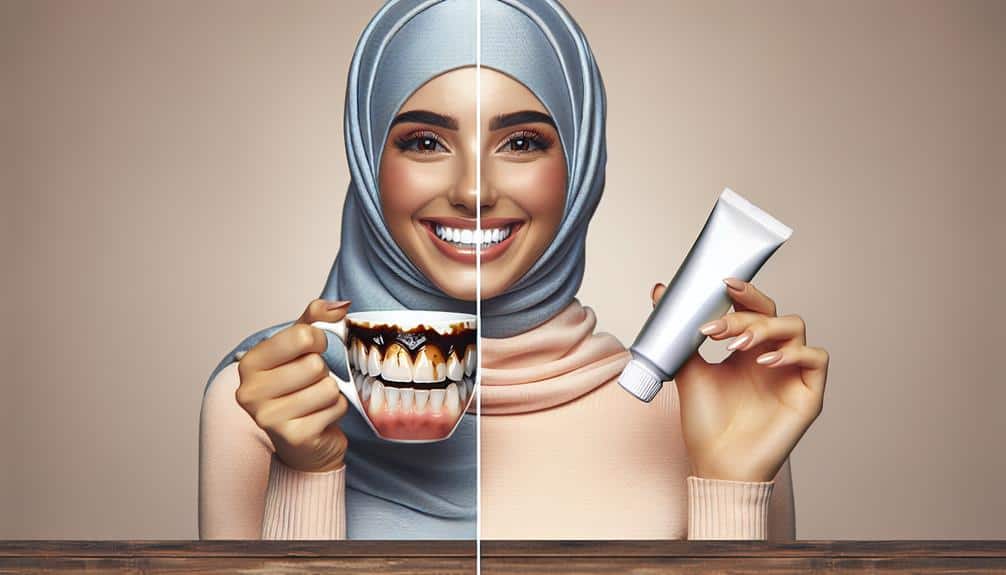Brighten your tea-stained teeth effectively with these seven proven techniques: utilize gentle circular motions with a soft-bristled toothbrush, try natural remedies like coconut oil pulling or crushed strawberries, follow a teeth-friendly diet, consider professional whitening options like in-office treatments, and maintain a healthy smile by prioritizing oral hygiene. Achieve a brighter smile starting with these techniques.
Key Points
- Use gentle circular motions with a soft-bristled toothbrush
- Try natural remedies like coconut oil pulling or activated charcoal
- Opt for professional whitening treatments for quick and noticeable results
- Maintain a healthy diet and oral hygiene routine for long-term brightness
- Consider in-office or at-home whitening kits with custom trays
Brushing Techniques for Tea Stains
To effectively remove tea stains from your teeth, consider utilizing gentle circular motions when brushing, targeting the areas where discoloration is prominent. Proper brushing technique is crucial in effectively combating tea stains.
When brushing, make certain that you're using a soft-bristled toothbrush to prevent enamel damage. Hold the toothbrush at a 45-degree angle to your gums and brush in small, circular motions. Pay close attention to the front surface of your teeth, as this is where tea stains tend to accumulate the most.
In addition to the brushing technique, using effective products can also aid in brightening tea-stained teeth. Look for toothpaste specifically formulated for whitening and stain removal. These toothpaste products contain ingredients like baking soda, hydrogen peroxide, or activated charcoal, which can help break down stains and brighten your teeth over time.
Remember to brush your teeth for at least two minutes, twice a day, to maintain good oral hygiene and combat tea stains effectively.
Natural Remedies for Teeth Whitening
Consider exploring natural remedies that can effectively whiten your teeth and reduce tea stains.
Herbal remedies, such as using crushed strawberries mixed with baking soda to create a paste, can help brighten your teeth due to their natural whitening properties.
Another option is coconut oil pulling, where swishing coconut oil in your mouth for several minutes each day may help remove stains and promote overall oral health.
Additionally, DIY treatments like brushing with activated charcoal or applying a mixture of lemon juice and salt can also assist in reducing tea stains and enhancing the whiteness of your teeth.
These natural remedies provide alternatives to conventional teeth whitening methods and can be incorporated into your oral care routine for a brighter smile. Remember to use these remedies in moderation and consult with your dentist if you have any concerns about their usage.
Diet Tips for Brighter Teeth
Explore how your diet can play a significant role in enhancing the brightness of your teeth and maintaining a healthy smile. Healthy eating habits can't only benefit your overall health but also positively impact your dental care routine. Consider the following diet tips to help you achieve brighter teeth:
- Avoid Sugary Foods: Sugary foods can contribute to tooth decay and discoloration. Opt for natural sweeteners like fruits instead.
- Increase Calcium Intake: Calcium is essential for strong teeth. Incorporate dairy products, leafy greens, and almonds into your diet.
- Eat Crisp Fruits and Vegetables: Crisp fruits and vegetables like apples, carrots, and celery can help remove plaque and stains from your teeth.
- Stay Hydrated: Drinking plenty of water helps wash away food particles and prevent staining. Aim to drink water after meals and throughout the day for optimal dental care.
Professional Whitening Options
Professional whitening options can greatly enhance the brightness of your teeth, offering effective solutions for achieving a whiter smile. In-office treatments provide a quick and efficient way to whiten teeth, usually in just one session. While these procedures tend to be more costly compared to at-home kits, they're performed by dental professionals, ensuring a high level of expertise and safety. The cost of in-office treatments can vary depending on the extent of whitening desired and the dental clinic's location.
On the other hand, at-home whitening kits are a more budget-friendly option that can also deliver noticeable results. These kits typically involve using custom trays filled with a whitening solution that you wear for a specified amount of time each day. While at-home kits may take longer to show results compared to in-office treatments, they can still be effective in brightening tea-stained teeth when used consistently. Following the instructions carefully is crucial to avoid any potential risks and maximize the effectiveness of the product.
Maintaining a Healthy Smile
To maintain a healthy smile, prioritize consistent oral hygiene practices such as brushing and flossing daily. This is essential for preventing plaque buildup and maintaining overall oral health. In addition to daily oral hygiene, regular dental check-ups and cleanings are vital for preventive care and catching any issues early.
Here are four key practices to help you maintain a healthy smile:
- Brush Properly: Use a soft-bristled toothbrush and fluoride toothpaste. Brush in gentle circular motions for two minutes, making sure to reach all surfaces of your teeth.
- Floss Daily: Flossing helps remove plaque and food particles from between teeth where your toothbrush can't reach. Make it a habit to floss at least once a day.
- Healthy Diet: Limit sugary and acidic foods that can contribute to tooth decay. Opt for a balanced diet rich in fruits, vegetables, and calcium.
- Stay Hydrated: Drink plenty of water throughout the day to help rinse away bacteria and food particles, maintaining a clean mouth environment.
Frequently Asked Questions
Can Tea Staining Be Completely Avoided by Switching to a Different Type of Tea or by Using a Specific Brewing Method?
To avoid tea staining, switching to different tea types or adjusting brewing methods can help. Experiment with white or green teas and consider shorter steeping times. Remember, prevention is key to maintaining a bright smile.
Is It Safe to Use Activated Charcoal or Baking Soda to Whiten Tea-Stained Teeth at Home?
When considering charcoal vs. baking soda for DIY whitening, remember both have risks. Charcoal, when used excessively, can be abrasive, leading to enamel damage. Baking soda, if too abrasive, can also harm enamel. Use with caution.
How Long Does It Typically Take to See Results From Professional Whitening Treatments for Tea-Stained Teeth?
Typically, it takes a few sessions over a week or two to see noticeable results from professional whitening treatments for tea-stained teeth. While results vary, many experience significant improvement in brightness. Professional treatments may cause temporary teeth sensitivity.
Are There Any Specific Foods or Drinks That Should Be Avoided to Prevent Further Staining of Teeth After Whitening?
To maintain your pearly whites after whitening, beware of dark elixirs and pigmented munchies that spoil your smile. Revamp dietary habits, embrace preventive measures, and ace your oral hygiene game to keep those teeth gleaming.
Can Tea-Stained Teeth Impact Oral Health in Ways Other Than Just Appearance, Such as Causing Bad Breath or Weakening Enamel?
Tea-stained teeth can impact oral health beyond appearance. The stains may indicate enamel weakening and gum issues. It's important to address this to prevent further complications like bad breath and decay.



